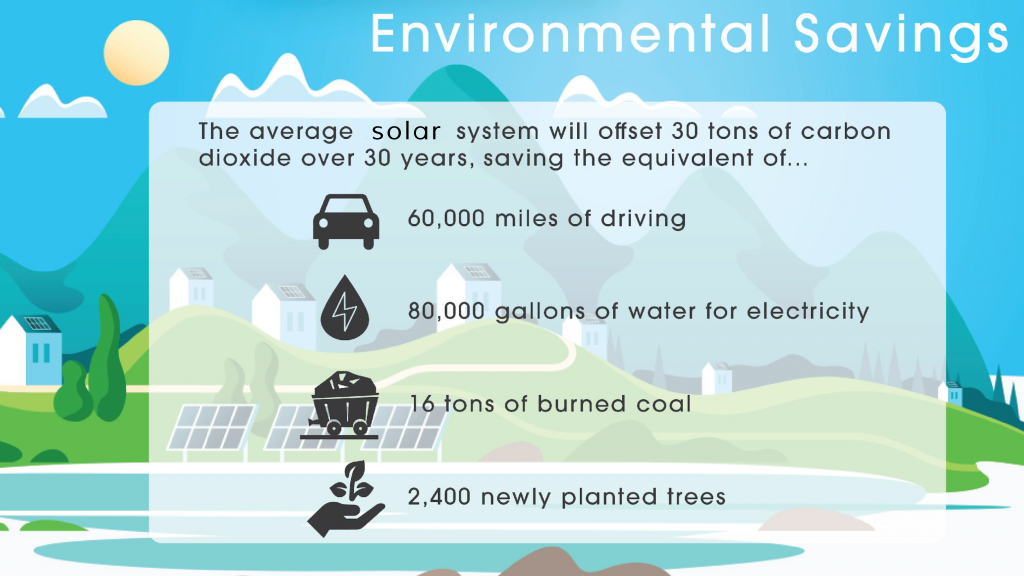- Questions? Call us at
- 1-844-537-4727
Environmental Benefits of Going Solar

7 Compelling Reasons You’ll Want to Go Solar
November 13, 2019
How To Keep Your Electricity Running During A Power Outage
November 18, 2019In a world where trying to make healthier or eco-friendly choices often comes at a premium (organic pink lettuce, anyone?), we’ve become accustomed to making the choice between what’s good for us and what’s in our wallet.
However, solar power just happens to be one of those rare unicorns, where you don’t have to make that Sophie’s Choice between your bank account and the rest of the planet.
Turns out, switching to solar is budget-friendly and eco-friendly; a win-win for all concerned.
In past posts, we’ve discussed the many ways going solar makes good financial sense. Today, let’s take a look at some of the ways this sun-powered form of electricity benefits the environment.
Helps to Protect the Climate
Decades of steady emissions and pollutants unleashed into the air are finally beginning to take a toll on our planet. It is no longer able to ward off the attack on the climate on its own.
The growing consensus from the scientific community is that we need to act now to lessen the burden we are placing on the environment, or risk irreversible changes to our planet. Solar energy and it’s small footprint on the world’s resources is a huge step forward in the fight against climate change.
Helps to Clean the Air
The dirty process of creating energy from non-renewable sources releases a massive amount of greenhouse gases into the atmosphere. Left unchecked, these gases destroy the quality of air we breathe. Solar power is able to be produced at a mere fraction of the CO2 cost to the environment, a savings which compounds year after year.
In fact, over a 30-year period, a solar power system can reduce the same amount of air pollutants as a forest of 2,400 newly planted trees!

Helps to Conserve Water
Another massive advantage that solar energy has over traditional power sources is its ability to reduce water usage. Generating energy from fossil fuels requires tens of thousands of gallons of water throughout the entire process. Excessive quantities of water are lost to cooling, extracting, converting and transporting electricity generated from fossil fuels. This results in a variety of devastating consequences; from undrinkable, toxic water, to droughts brought on by ever-increasing demands for power.
Solar power does not require any water to be produced. And it doesn’t need to be cooled by water. The only water a solar energy system needs is for occasional cleaning of its panels (an incredibly tiny amount as compared to water-guzzling fossil-fuel energy). Each home that goes solar saves 80,000 gallons of water over its lifetime.
Helps Break our Dependence on Non-Renewable Energy Sources
The fossil fuels that traditional energy comes from are a non-renewable source. Once they’re gone, they’re gone. As the world population expands, the shrinking supply of coal, oil and other fuels will become increasingly expensive and difficult to source.
It doesn’t take a degree in economics to recognize that this supply and demand balance is not sustainable. Switching our energy use to renewable sources (such as the sun) helps restore the balance sheet in our favor.
The Positive Effect on the Human Race
It should come as no surprise that the same hazardous conditions that threaten the environment pose a similar detrimental effect on all those who live within that environment.
Prolonged exposure to the pollutants emitted into the air by traditional energy sources such as oil, coal, and gas has been linked to any number of respiratory ailments and cardio health issues such as asthma, bronchitis, heart attack, and stroke.
Water that has been contaminated by toxic runoff from the burning of fossil fuels also causes a domino effect of carnage. It affects everything from the fish that swim in polluted bodies of water, to us humans, who unknowingly consume these contaminated fish and drink the unsafe water. Every single environmental menace eventually moves on to put humanity itself at risk.
The sooner we take steps to move toward renewable resources such as solar energy, the greater our chances become to reverse the strain on our planet and ourselves. And for once, what’s good for you makes good financial sense as well. With a track record of over 30 million tons of carbon dioxide eliminated, we’re experts at assisting homeowners in making the switch to solar. To find out how you can go solar, click here.




